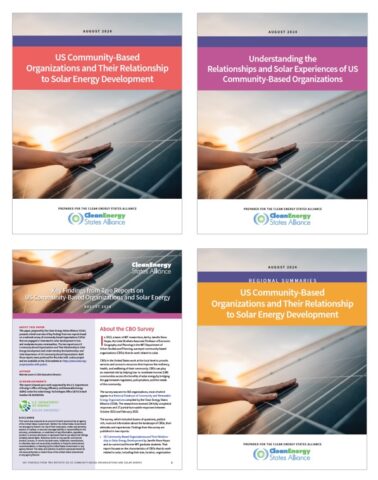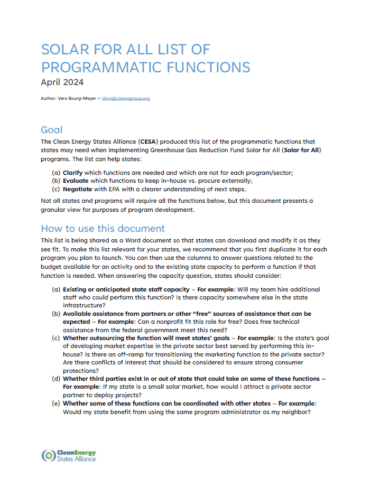Resource Archive - Solar PV
SEARCH RESOURCES
You can also search by author name.
RESOURCE TYPES
RESOURCE TOPICS
RESOURCE PROJECTS
RESOURCE YEARS
This report compiles research on best practices for designing solar programs that provide meaningful benefits to low-and-moderate income households. The report examines different types of solar projects, including residential-serving community solar, rooftop solar, and installations serving multifamily affordable housing. It includes six case studies and information about savings verification.
This directory lists and describes federal and state resources for educating consumers about solar opportunities and considerations.
This CESA presentation within the Meaningful Household Savings Community of Practice summarizes best practices, pathways to scale meaningful household savings, and research needs.
This paper presents recommendations to help state energy agencies design and implement equitable stakeholder engagement strategies for their solar programs.
This document, part of CESA’s IRA Explainers and Guides Series for States, answers questions about the Build America, Buy America (BABA) Act and the domestic content bonus tax credit program requirements for awardees of the Greenhouse Gas Reduction Fund Solar for All program. It will be useful to other stakeholders as well to understand how BABA will apply to Solar for All and the differences between BABA and the tax credit requirements.
CESA has released a series of reports based on the findings of a nationwide survey of community-based organizations (CBOs). The survey, which included dozens of questions, yielded rich, nuanced information about the landscape of CBOs, their attitudes and experiences.
CESA produced a series of video interviews on the topic of advancing solar for low-and moderate-income communities through collaboration between state energy agencies and community-based organizations.
This deck is a short series of recommendations to Community-Based Organizations (CBOs) that wish to better understand the Greenhouse Gas Reduction Fund Solar for All competition and how to engage with the Solar for All opportunities. It briefly introduces the Solar for All competition, offers a realistic timeline for programs and funding deployment, and suggests concrete steps and resources for CBOs to support states in ensuring the success of the program.
Washington, DC’s Solar for All program aims to benefit over 100,000 households with incomes at or below 80% of area median income. This case study profiles the program and the ways its administrators have handled outreach and consumer education over the program’s seven-year history.
This document is a comprehensive list of the functions needed to design and deploy a low- and moderate-income solar program as part of the Greenhouse Gas Reduction Fund Solar for All competition. This list can help states clarify which functions are needed and which are not for each program/sector, evaluate which functions to keep in-house vs. procure externally, and negotiate with EPA with a clearer understanding of next steps.










